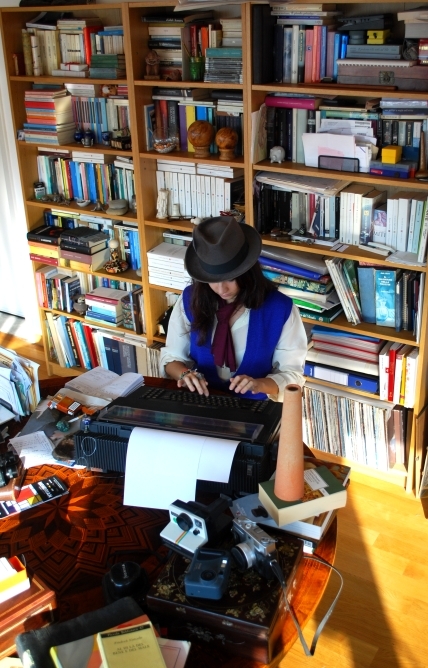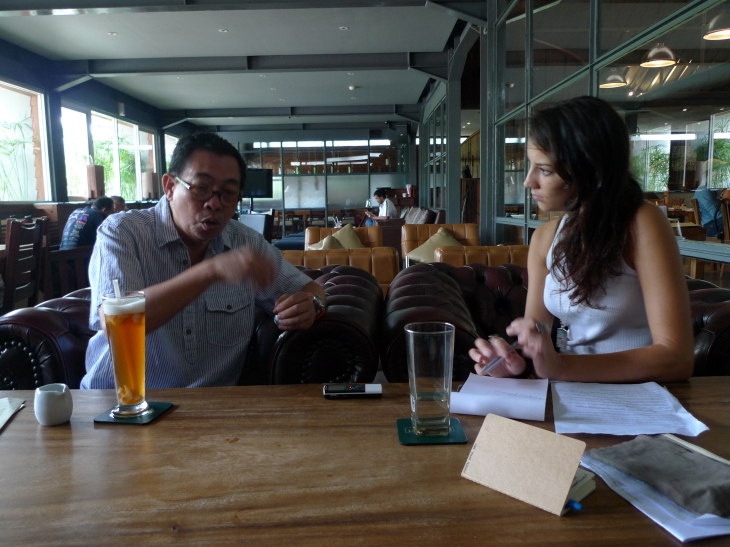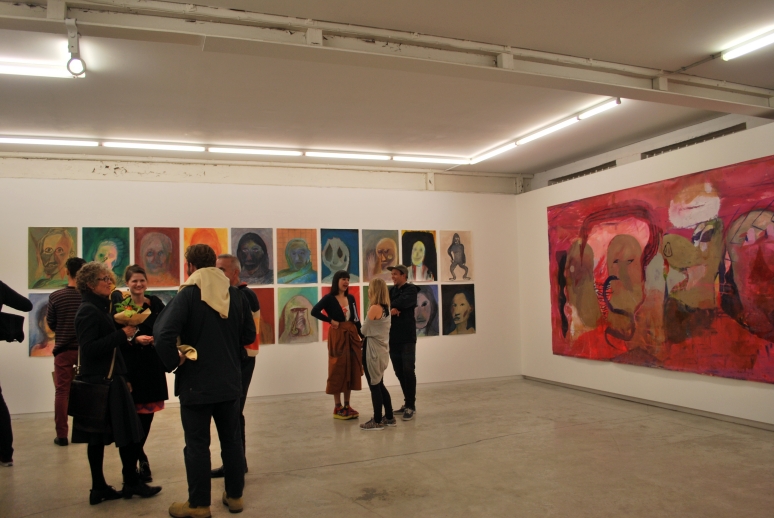How to prepare a contemporary art reportage based on a city

I just come back from Perth, Western Australia. I was there for a reportage about the local contemporary art scene.
Before leaving I wrote this list to clarify my own ideas and to see what I learnt from my mistakes.
Maybe someone else could find it useful too.
“To be an art reporter is fun, but if you don’t plan everything in the details it can be very stressing.
If you are lucky someone, maybe the magazine you collaborate with, has sent you in foreign city or country to do an amazing five pages reportage about the local art scene. If you are extra lucky maybe your magazine would be also open to pay you for that.
But you know, even Oriana Fallaci and Martha Gellhorn would have an hard time to find good assignment nowadays.
Times are tougher and tougher, especially in the field of contemporary art.
If you’re an enterprising free lance journalist or art critic you can probably decide to make a project of your own and try to sell it later to magazines and newspaper. Maybe you can even make a book out of it.
Anyways remember to plan every step in advance.
1. Focus your research
The first thing you have to do is to focus your research. Maybe you are interested just in the painting scene of that city, or just in the hipster scene, or the influence of craft on contemporary art.
Or maybe you want to have a general picture, not very specific but quite thorough.
This second kind of macro reportage is the one I personally like the most. However my tips are valid also if you are conducting a more specific research.
2. Make a previous research on the city
Have a quick look of what other people already wrote about the art scene. Don’t exaggerate, it’s better to not build preconceptions based on what other people thinks. The best thing to do is read a novel or two set in the city you are going to visit. Have a look at a very general travel guide that gives you neutral information, like Lonely Planet or something like it.
If you find some catalogues of exhibition about artists from the city that you are going to visit, try to have a look at it.
If you know someone in your own city that has a link with the place you are going to visit, talk with them, either informally or with an interview.
If these people have a link to the art world is better, but don’t undervalue the impressions of friends or acquaintances disconnected from the scene.
3. Find the artists to interview
First thing you have to do is to find the artists that you are going to interview. Maybe you focus on a particular field, let’s say video art. To save time you can probably start searching on google the names of the galleries in the city interested in video art. From there you can find the list of the artists associated with the gallery and check their work. Usually the galleries have a selection of images of the artist’s work.
Maybe you can find the mail address of the artist straight on the gallery website. Maybe you can find the mail on the artist personal website. A lot of artists don’t have a website though.
In this case you can mail the gallery explaining that you are an art writer/critic/journalist and you are making some researches about the city’s art scene. You can probably refer to the main magazine you write for, if you are a regular contributor. That gives you credit.
4. Refer to other professional figures
Talk with artists is very important to understand the art scene of a city, but it is also important to have a chat with other professional figures that work in the art field. They will probably gives you a picture that is more complete and less personal compared to the one of an artist.
If you want to give a complete overview of what’s going on in the artistic scene of a city, you have to interview at least one director or curator from a public institution, an owner of a private commercial gallery and hopefully a director/curator of an independent underground space.
Don’t shrug off your fellow art critics and art journalists. Probably the city has a local art blogger who keeps track of all the art movements in the city. He will probably gives you precious insight that you couldn’t have in your limited amount of time.
If this insighter is not a blogger, maybe is a journalist from a local magazine. Take the chance of interview the director. It is also a contact that you can keep for the future.
Sometimes collectors open their collections to public visit. Sometimes not. Either way, if you have the chance of interviewing a collector it’s always good. That gives you an other prospective, and different perspectives are very important to you.
5. Mail them
A mail is the more professional way to contact these people.
You are better off if you have a professional mail address and if you put under your name your personal website and the link to the web magazines you write for. Write a standard text that you can send to all the people that you want to interview, but of course, change names and detail to personalize the mail to everyone.
You can usually have interviews in a café, in the artist’s studio or in a gallery.
Just be sure to have a special folder in your mailbox where you store all the e mails and an organized folder in your computer where you save all the recordings and the pictures.
The biggest in the work, the more accurately has to be your organisation. It’s very easy to lose something, to forget to mail someone, to miss an appointment, to lose face.

6. Schedule your visit
Either if you have five months or if you have five days to realize your reportage, you have to try to plan in advance as much as possible. Then, of course, other opportunities will come along.
You will probably interview an artist who will suggest you a friend artist. A curator who will give you the mail of his favourites. You have to push that as well. Ask people to suggest you other people.
For succeed in that you have to leave room in your plan to the unforeseen.
Be sure to not be busy every day. Maybe some of these opportunities will not come up, so be sure that you won’t waist your precious afternoons on facebook and plan a visit to minor galleries.
Obviously a visit to major galleries is a must. Try to write reviews short after you visit the exhibitions. Go to the openings as well. That is very important to spot how the art folk there is like.
7. Take as much multimedia material as you can
Take pictures. Make videos. Sure, you’re neither Cartier Bresson nor Luc Besson, but whatever.
Visual material is an important surplus to add to your words. After all we are talking of visual art, right?
Of course, you don’t have to forget to ask the gallery to send you pictures of the exhibitions you visit, but at the same time be sure to take your own pictures, especially when comes to art openings and special events. Collect the flyers of the exhibitions and the press releases in a special fold.
Ask galleries and artists for catalogues and keep them. You will later put them in a special shelf in you “reportage” section of your library.
Don’t limit yourself to art events. There is always something typical with a city that you can write about. Usually the real typical will come to you quite naturally, be careful to not overview it.
Don’t concentrate of the exotic. If you are going to trace the art scene in Paris, please try to avoid to refer too often to the Tour Eiffel. Unless you do it in an ironic way.
When you have spare time go to the markets, try to live (or at least understand) the everyday life of the city. Talk with people disconnected to the art field.
8. First impressions
When you came home at night after a busy day in the local art world, gather your last energies to write down on a notebook the impressions of the day. Can be a conversation among friend that gives you an anthropological insight of the local youth, can me your impressions about artist studios, or maybe just a excerpt of conversation overheard in an opening.
Start the first pages of your notebook with your expectations about the city before actually have being there.
Maybe you will find your first impressions wrong, but this notebook will became for you an important tool to compare expectation and reality. The process of discovering can be an interesting cue for your reportage.
9. Do the interviews
That’s the most fun part. You know new people, and usually artists are either interesting people or pretentious assholes. They will give you material to write about for sure.
With other professional figures maybe can be a little bit different, but a chat can always be worthwhile.
Often artists have an articulate way of talking and they don’t follow a clear line of thinking when they are explaining their work. There is a reason why they decide to express themselves with visual art instead that with words, so it makes sense.
Try to be as clear as possible in your questions, but be flexible at the same time.
Don’t stick to the questions you prepared. Make the interviewed feel at home making a conversation more than an interview, but be sure to have asked her/him all the questions you wanted to ask. The “conversation with an artist” that end up talking of useless thinks instead of the art are the most boring postmodernist invention on the contemporary art catalogue. Totally a waste of ink. Be a relaxed professional, don’t be a waster.
10. Keep the contacts
Maybe you will never came to that city or that country again in your life. Or alternatively you will come back to do more research about the local art scene. Maybe in your next reportage you will wide your research to the country in general.
Anyways, it’s important for you to build the contact. Maybe your acquaintance with the local art journalist will provide you a mention on the local newspaper when your reportage will be out.
You will be more likely remembered by the artists if you meet them more than once. You can do the interview in a cafè first, visit their studio later and going to an exhibition together the third time.
Try to build a friendly relationship with the artists which work you appreciate the most.
If you are not only an art writer but also a curator you can think of organize an exhibition complementary of your reportage in a gallery of your own city.
The import/export factor is an interesting way to connect artists, aesthetic and create innovative projects.
Artists travel nowadays, so it’s very likely that you can meet them again in the future.
A business card wallet is a must. Again, be sure that the folders in your mail box and the files in you computer are well organized.
Following these tips the next steps (organize the material, write the actual reportage and publish it) will be much easier. Keep in mind that even if you try to plan as much as possible, the majority of your work will be improvisation. For control freaks is much harder to survive in this job. In the end mix these tips with your own way of doing things.”




